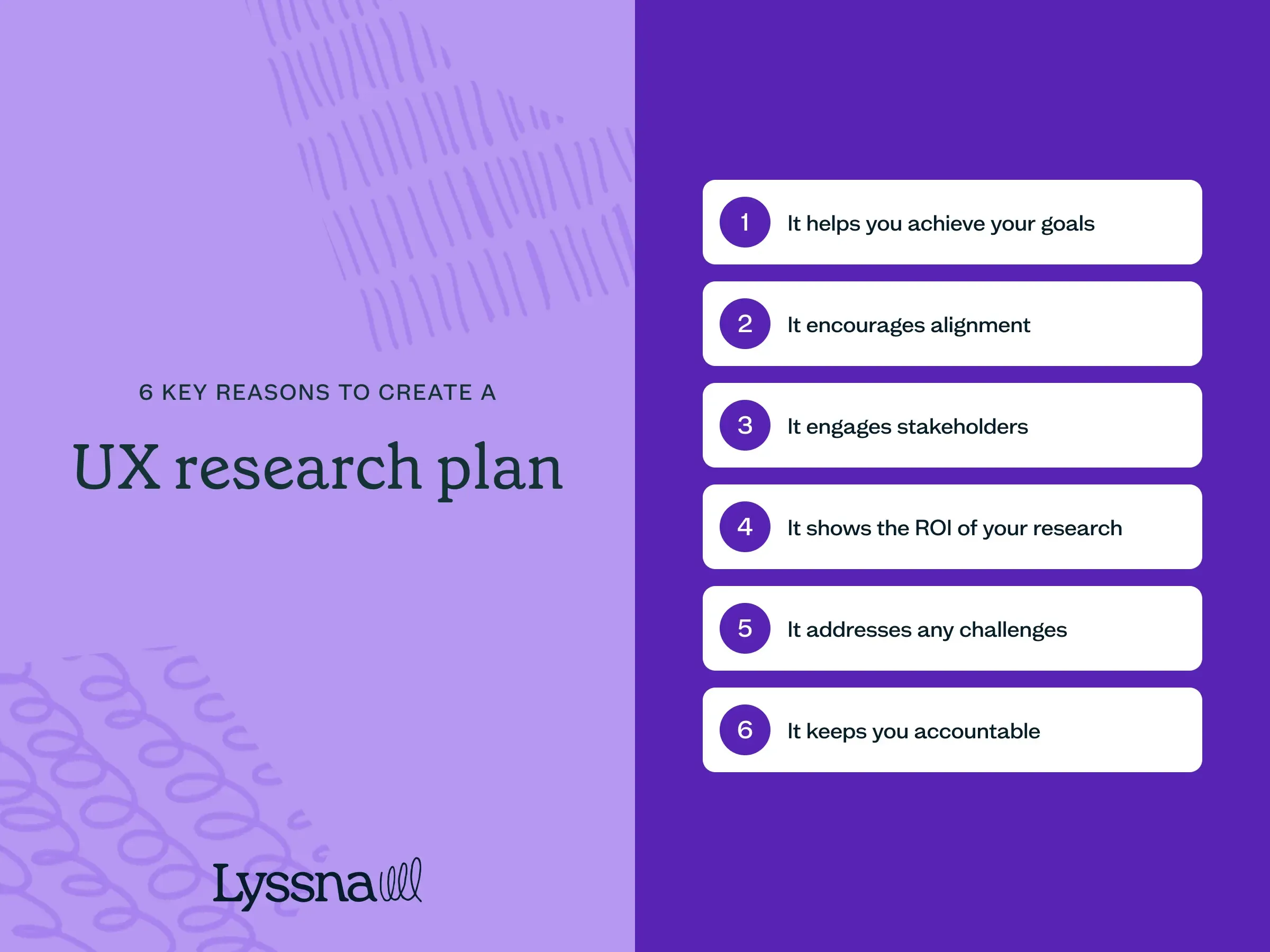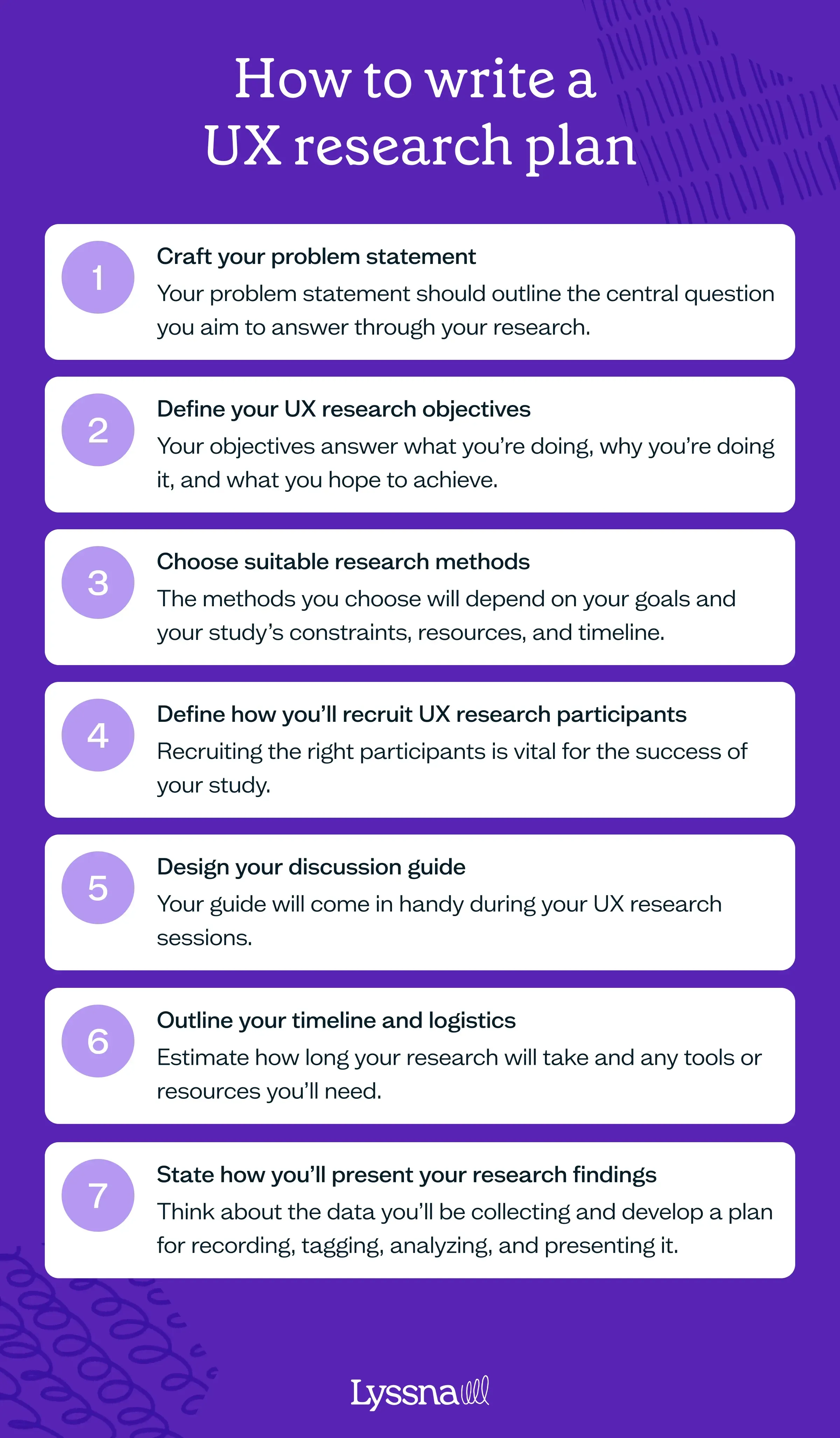UX research plan
Approaching your study with a detailed plan will set your research off on the right foot. A well-considered plan includes your goals and research questions, details how you’ll conduct your research and the methods you’ll use, and outlines your timeline, recruitment methods, and how you’ll present your results. Putting time into your plan will pay off later down the road, because you’ll know exactly what to focus on when faced with lots of raw data to sort through. In this chapter, we’ll cover everything you need to know to get started. Let’s get planning!
UX research guide
What is a UX research plan?
A UX research plan is a detailed guide for your research study. It outlines the objectives, methods, and logistics of your study, making sure that everyone involved is on the same page and aware of the expectations and goals.
Your plan should cover your research objectives, who will be involved, when and how you'll conduct the research, and what you hope to achieve. It serves as a handy reference throughout the project, helping you stay focused on the main research questions you're seeking to answer.
Why is a UX research plan important?

We briefly touched on this above, but let’s explore the core reasons why a UX research plan is important to the success of your study.
It helps you achieve your UX goals
A solid UX research plan keeps you focused on your goals throughout the study. It serves as a reminder of what you want to achieve and tracks the progress you've made. With a clear plan in place, you can stay on track and make sure your research efforts are moving you closer to your desired outcomes.
It encourages alignment
A UX research plan helps to keep everyone on the same page. It ensures that your entire team understands the project’s objectives, timelines, and expectations. By having a plan in place, you can spot conflicting interests early on and address them before they become major roadblocks.
It engages stakeholders
A well-written research plan is a great tool for involving stakeholders. It allows them to become active participants and understand how the research aligns with business objectives.
A good plan addresses stakeholder concerns, sets realistic expectations, and provides a concise overview of the research methods and logistics involved. This engagement helps you gain stakeholder buy-in and makes sure everyone is on board with the research process and expected outcomes.
It shows the ROI of your research
Stakeholders are often interested in the results and impact of the research more than the process itself. A UX research plan clearly outlines the objectives of the research and how they'll benefit the product or business. It helps you articulate the value and return on investment (ROI) of the research, which is crucial for gaining support and resources.
It addresses challenges
UX research can be fraught with challenges, such as no-show participants, unqualified participants, or disorganized data. A research plan helps you anticipate and plan for these risks.
As you develop your plan, you can identify potential issues and refine your research approach. By addressing these challenges proactively, you can improve the quality of your research and increase its effectiveness.
It keeps you accountable
When you write down your research plan, it keeps you accountable. It reduces the risk of missing important steps, going over budget, or losing sight of your objectives. Think of the research plan as a checklist that makes sure you’ve covered all the necessary aspects of your research so you can stay on track from start to finish.
How to write a UX research plan
In this section, we walk through each step of writing a UX research plan, from defining your problem statement to presenting impactful research findings.

1. Craft your problem statement
A solid UX research plan begins with a clear problem statement that outlines the central question you aim to answer through your research findings. This statement should clearly identify the problem you’re seeking to solve and provide enough detail for stakeholders to understand the purpose and objectives of the research. Take the time to explain the project, its background, and the desired outcomes you hope to achieve.
Inspiration for your problem statement could come from your customer support team (who have firsthand knowledge of customer issues), exploring customer reviews on platforms like G2, NPS survey results, and feedback received via social media. By assessing this existing data and identifying the gaps in your knowledge, you’ll lay a strong foundation for building a robust research plan.
Remember, a well-crafted problem statement sets the stage for your research, making sure that everyone involved is aligned and working toward a common goal.
2. Define your UX research objectives
Once you have a clear problem statement, it’s time to define your research objectives. These objectives answer what you’re doing, why you’re doing it, and what you hope to achieve.
To set effective objectives, consider the end goal you want to accomplish through your research. Think of it as telling a story – what’s the purpose behind your research and what insights do you expect to gain? It’s important to set specific objectives, as they'll help shape the project scope and guide the questions you ask your participants.
By setting clear and meaningful objectives, you ensure that your research has a purpose and direction. This will help you focus your efforts, gather actionable insights, and make informed decisions throughout your UX research journey.
Example objectives
Here are some examples of undefined vs clearly defined UX research objectives:
Unclear objective: “We want to understand user behavior on our app.”
Clear objective: “We want to identify the most common user paths and interactions on our app to optimize the user flow and improve conversion rates.”
Explanation: The first objective is vague and lacks specificity. It doesn't provide a clear direction for the research or indicate what insights are needed. The improved objective is specific and outlines a clear purpose for the research.
Unclear objective: “Get feedback on our new website design.”
Clear objective: “Evaluate user perceptions and usability of our new website design through usability testing to identify areas for improvement and ensure a seamless user experience.”
Explanation: The first objective doesn’t specify the purpose of the feedback or what aspects of the design need to be evaluated. The second statement states the goal of evaluating user perceptions and usability, and explains how this will be gathered – through usability testing. It also highlights the desired outcome of identifying areas for improvement and ensuring a seamless user experience.
Unclear objective: “Learn about our users’ preferences.”
Clear objective: “Conduct user interviews and surveys to gather insights into user preferences regarding color schemes, font styles, and layout options to inform the visual design of our mobile app.”
Explanation: The first objective is broad and doesn’t provide specific details about what user preferences are being explored. The improved objective clearly defines the scope of research by specifying the areas of user preferences related to color schemes, font styles, and layout options for the mobile app. It also mentions the research methods being used.
3. Choose suitable research methods
Choosing suitable research methods for your study depends on various factors such as your goals, the product development phase you’re at, and the project's constraints, resources, and timeline. Often, a combination of methods will be used to gather comprehensive insights.
Working out when to use formative methods versus summative methods is important. Formative methods, like interviews and surveys, help you uncover insights early in the design process. Summative methods, such as card sorting and first click testing, are useful when you have a prototype or refined designs to test.
In the UX research methods chapter of this guide, we delve into methods in detail. Once you have a clear understanding of the results you want to achieve, you can make sure the methods you choose align with your objectives and will provide the evidence you need to make well-informed decisions.
Templates can be a fantastic starting point when creating your research plan. Take a look at our collection of test templates to explore various methods and find inspiration for your own research approach.
4. Define how you’ll recruit UX research participants
Engaging with the right participants is vital for the success of your UX research project. In your research plan, you’ll need to outline the details of participant recruitment. We go into more detail about this in the UX participant recruitment chapter.
First, clearly define the characteristics of the participants you’re seeking. Make sure that your selection aligns with your research goals and the specific questions you aim to answer. By targeting individuals who represent your target audience, you’ll gather insights that are relevant and valuable.
Next, describe your recruitment approach. Will you be leveraging a participant panel or reaching out to your own user base? Clearly outline the methods you’ll use to connect with potential participants.
It’s also important to specify the desired number of participants for your study. The appropriate sample size will vary depending on your research methods and the nature of your project. Be sure to determine the number of participants necessary to gather enough data and generate reliable results.
Don’t forget to address the topic of participant compensation. You can explore examples of incentives for participation in research studies to determine effective ways to motivate individuals who contribute their time and insights to your research. Whether it’s financial compensation, gift cards, or other forms of recognition, make it clear how participants will be compensated for their involvement.
Check out this webinar we co-hosted with Tremendous to explore what participants expect to be paid considering factors like the method and study length.
Example
Here’s an example to illustrate participant recruitment in a UX research plan:
Participants: We’ll recruit participants who are active users of our mobile app and represent our target user demographic [include details], including both new and experienced users.
Recruitment methods: We’ll use a combination of our own user database and online participant recruitment platforms to identify potential participants. An email invitation will be sent to our user base, inviting them to participate in the research. Additionally, we’ll leverage a participant recruitment platform to reach out to individuals who match our desired participant profile.
Sample size: We aim to recruit a total of 20 participants for this study. This sample size will allow us to collect diverse perspectives and ensure sufficient data for analysis.
Participant compensation: To show our appreciation for their time and contribution, participants will receive a $50 payment upon completion of the research session.
5. Design your discussion guide
In this step, you’ll create a discussion guide that you’ll use when conducting your UX research sessions. This will help to keep you on track to meet your objectives and ensure meaningful discussions with participants.
Your guide should include several key things:
Introduction: Start by outlining how you’ll greet participants and provide them with a clear understanding of the purpose of the research. This sets the stage for a productive and comfortable research session.
Interview questions: Include a list of example questions that align with your research objectives. These questions will guide your interviews and help you gather the insights you need. Consider asking open-ended questions to encourage participants to share their thoughts and experiences freely.
Wrap-up: This is what you’ll say at the end of the session. This includes summarizing the key findings, discussing next steps, thanking participants for their time and contributions, and addressing compensation.
If you’re conducting unmoderated research, such as unmoderated usability testing, your guide might include prompts or tasks for participants to complete on their own.
Remember, your guide should be flexible enough to accommodate unexpected insights and adapt to the dynamics of each research session.
Example
Introduction: Welcome participants and explain that the purpose of the research study is to gather feedback on a new website design. Emphasize that their insights are crucial in helping to improve the user experience.
Interview questions:
Can you describe your initial impressions of the website?
How easy or difficult was it to navigate through different sections?
Did you encounter any issues or challenges while using specific features?
What aspects of the website stood out to you positively?
Is there anything you found confusing or unclear?
Wrap-up: Thank participants for their valuable input and highlight that their feedback will contribute to enhancing the website. Explain that you’ll analyze the findings and share any follow-up steps or improvements based on the insights gathered. If applicable, provide compensation details and express your appreciation for their time and effort.
6. Outline your timeline and logistics
Establishing a clear timeline and outlining any logistics required are also important considerations to include in your UX research plan.
Start by estimating how long the research project will take from start to finish. Consider factors such as the number of participants, complexity of research methods, and data analysis requirements. This estimate will help you manage stakeholder expectations and plan other project activities accordingly.
Identify the UX research tools or resources you’ll need. This could include usability testing tools, interview recording tools, etc. Specify any specific requirements or preferences related to these tools.
It’s worth also clearly defining the roles and responsibilities of team members involved in the research process. This includes researchers, designers, and any other stakeholders contributing to the project. Assigning responsibilities makes sure that everyone understands their role and contributes effectively to the research study.
Including this information in your plan will help to create a structured framework for your research project and manage stakeholder expectations.
7. State how you’ll present your research findings
Effective research analysis begins at the planning stage, even before the research actually begins. Think about the type of data you’ll be collecting and develop a plan for recording, tagging, analyzing, and presenting it.
Consider creative ways to present your findings. This might be a written research report, an interactive report with video snippets from participants, or a digital whiteboard that displays results visually. You could also consider scheduling a dedicated session to present your findings at the end of the project. By tailoring your presentation to the preferences of your stakeholders, you’ll increase the impact and engagement of your findings.
We go into more detail about analysis and reporting in the UX research analysis and UX research report chapters of this guide.
After you’ve completed your study, consider holding a retrospective to reflect on what went well and what could be improved. Use this feedback to refine your UX research plan, and turn it into a reusable template that you and your team can use for future projects.

Key elements of a solid UX research plan
A well-structured UX research plan sets you up for a successful study. In this chapter, we’ve covered the essential aspects of how to create one, including:
Problem statement: Define your central research question clearly to provide a foundation for your study.
Research objectives: Determine what you want to achieve and why, ensuring your research has a purpose and direction.
Research methods: Select the most appropriate methods for your goals, considering the stage of design and available resources.
Participant recruitment: Specify participant characteristics, your recruitment approach, sample size, and compensation.
Discussion guide: Craft questions and prompts to guide meaningful discussions with participants.
Timeline and logistics: Estimate project duration, list required tools/resources, and clarify team roles.
Presenting findings: Plan how you’ll analyze, record, and present your research results effectively.
With a comprehensive plan in place, you’ll stay focused, be aligned with stakeholders, and be on the path to gathering valuable user insights.
